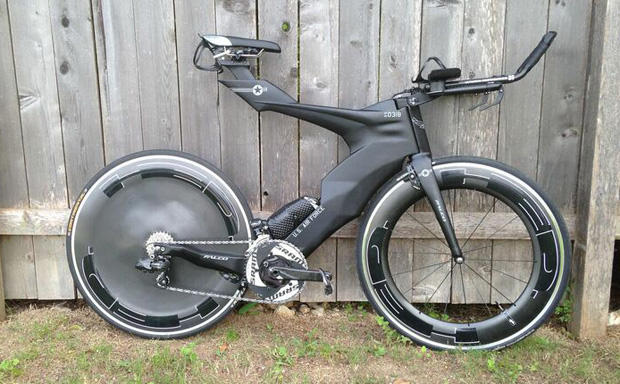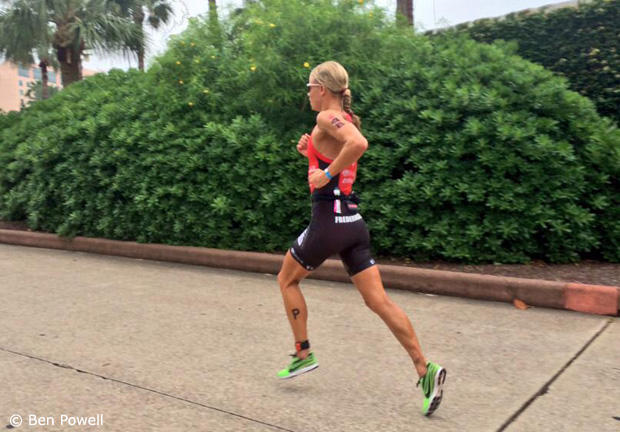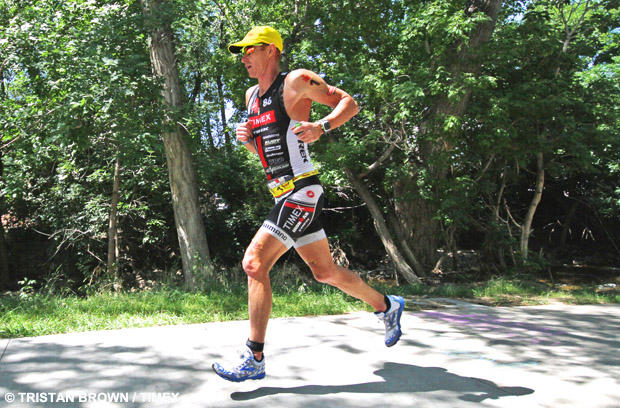The new life of Brad Williams
Brad Williams left the active military duty late last summer and got a pro card at the beginning of the year. The RWB athlete talked with us about moving to Europe, racing, training, marriage, the pro card, bike splits, Texas, rumor mongering and much more. It is also a nice juxtaposition when compared to the interview with Colin Laughery who was contemplating that step to get a pro card when we chatted with him.
ST: It is god to chat with you Brad.
Brad Williams: Thank you Herbert.
ST: Why are you now living in the UK?
Brad: My wife is going to school to work on her PhD at Oxford, so being married to her I had the luxury to join her and stay in Oxford for the next 3 years. We enjoy it over here and we kind of have been here since the middle of October last year. But I have counted the time and I think I have only been 9 weeks here. I have spent quite a bit of time in the States in January, March and April. I pretty much missed most of the winter here and the weather is just now getting nice.

ST: You also turned pro in that period of time.
Brad: Yeah and the whole pro term is interesting. I got out of the Air Force in August and I was obviously not ready to take my pro card then. I kind of wanted to go back to race Kona one more time, and did 70.3 Worlds and Kona in 2014. I then waited until January 1 so I would not have to waste $45 for what was left of 2014. I did more focused training starting in early July. Well that is when I stopped doing work, but I officially separated from the Air Force in mid August. And that meant I was no longer on active duty.
ST: During that last year on active duty, did you always have it in your mind to turn pro?
Brad: I had spent 6 years overseas. I did 2 years in Korea, 15 months in Turkey and then 2 more years in Korea, and just before Kona 2012 I came back to the United States. Then the plan was that I would race a full schedule in the United States just to see how I stacked up. I had not really raced before in the USA except for a few times here and there. So I set up a heavy schedule for 2013 to see what it would take financially to race fulltime basically. I was still in the military, but I tracked my financials just to see what it would take if I wanted to make that leap. I think it was around $15,000 for the year with travel and everything else. The question of turning pro was then an issue of how I would progress. I actually qualified [for a pro card] twice in 2013, but I stepped back and told myself that it wasn’t the right time to race pro. I also still had a full year of military left and I got married around that time. It was a very busy time in my life. At the time I was getting beat by girls like Alicia Kaye, and I saw that as a sign. Granted I was getting beat by girls in 2014 too, but the timing was just better.
ST: You mentioned it took you $15,000 to live for a year to race. I assume that was not living lavishly.
Brad: I was staying in regular hotels, and at a couple races I was able to stay with my parents. Which I guess was the same as a homestay. When I went to South Beach I roomed with a couple other athletes, and was in general pretty smart financially. I took a $1,000 pay cut [a month] when I came back to the USA, so financials were definitely on my radar. I was pretty smart with my budget but I was still racing as much as I could. I racked up a bit of debt doing that but really wanted to know what it would take.

ST: But you also knew that you would not have money coming in right away when racing as a pro. So how did you plan to pay for those expenses?
Brad: We had not gotten married yet and I did not know what the plans were with our relationship and where that was going to go. So there were two options. We were either going to get married and I would go with her wherever school took her, and I was going to make things work that way. We were both in the military and had saved up a decent amount of money, and we figured we had about 2 years where I could take a complete loss and continue to race. We then would reevaluate the situation and see where we were financially. The second option, before wedding was on the table, was that I would get out and use the Montgomery GI Bill, go to school and get a master’s degree. They give you a stipend depending on where you live, anywhere from $1,000 to $2,000 to cover housing etc. But I was going to take the path less traveled and live at home as a 28-year old, and use that money to make ends meet, continue racing and work on my degree.
ST: It sounds like plan A was preferred for many reasons.
Brad: Oh yeah, our relationship progressed and we got married and I am still working to this day. I work for a non-profit called US Military Endurance Sport and do about 15-25 hours a week. I can do it from home and on my time schedule. That is nice and brings in a little income. I also volunteer for Team Red White & Blue, so I can keep my resume active. So I can show in 10, 5, or 2 years from now, when I need to look for a job, that pro triathlete is not the only thing on there.
ST: Talk about that 2-year window of opportunity. What would it take for you to continue racing as a pro and what would be causing you to walk away and get a job? Is there some kind of target?
Brad: It is a moving target and it is not financially based per se. It is more about if I keep progressing as an athlete, and what I can line up in terms of business partners and sponsorship, and also prize money. So there are several variables there, that hopefully will slowly progress over the years. I built up some solid relationships as an amateur, with no money involved and just product and discount based. Now those are starting to blossom and hopefully I can start to build up a pro resume that I can seek out some sponsorships with that help a little bit financially. The biggest thing is, I don’t want to be a burden on our marriage and if we are going to have a family.
ST: Will you look for sponsors within the triathlon industry or outside?
Brad: In the position I am in it is pretty hard to branch outside. I have one sponsor that you could consider as non-endemic, and that is a massage company out of Pleasant Hill [California] and that is Massage Envy of Pleasant Hill, and that is someone I worked with when I was in Korea. But everything else is pretty much industry related other than Spinlister, the new bike share program. They came on board and we hooked up. But you could consider them endemic though.

ST: What is next for you in terms of racing after this Texas race?
Brad: Texas is more than likely my only race in the USA, as there really are no other trips planned to go back to there until late fall and winter. Luckily I now have the flexibility to not have to plan too far in advance. We do have a rough plan but it can certainly change. Right now I am looking at doing Challenge Rimini in Italy, and then come back and do a 3-4 week block of training and then do Staffordshire 70.3, which is here in the UK. The first Ironman for me this year will be Ironman Bolton, and that is the first half of the year. I will take a mid-season break in August and go on a 2 week cruise in Norway, Iceland, Scotland and the Faroe Islands. Then I will re-evaluate when we come back, but likely do Challenge Weymouth. [full]
ST: How deep do these races pay?
Brad: Luckily Challenge pays 10 deep and at Ironman it depends. I think Staffordshire is only 6 deep and Ironman Bolton may be 10 deep. It is 8 for sure but might be 10. It is a $75,000 purse.
ST: $75,000 is not shabby.
Brad: There was another 70.3 I was looking to do here in the UK, but I does not have a pro purse. They claim they moved that money over to Bolton.
ST: I noticed you ride a Falco now.
Brad: I partnered with Falco back in January or February and I received the bike the first week of March just before I left for the States. I tore down the Cervelo and built up the Falco in 15 hours between 2 days. And I was on a flight to the USA 40 hours later. It was a pretty quick turnaround to get on the bike, but the geometry is very close to my P3 and I was able to get the fit that is almost identical.
ST: Why did it take 15 hours to get it together?
Brad: I did it all on my own and I ran into a couple problems with the TRP brakes. I am not a professional mechanic – I can do my own maintenance, but tearing down the P3 completely and building up that Falco was a big bike build learning experience.

ST: I assume you were patient.
Brad: I put up a time-lapse video on my blog about it, and I think you are doing something like this right now with your house. It took a bit of time, but it was fun.
ST: How much of your training are you doing on a TT bike versus a road bike?
Brad: It is probably 95% on my TT bike, and the last time I touched my road bike was at a camp in Tucson, Arizona about a year ago. I like to be on the TT bike, that is what I race on, but here in the UK I got a lot of funny looks when I showed up on a group ride with my TT bike. So I figured I better start showing up on my road bike so they don’t think I am crazy and actually let me ride with them.
ST: What about wheels? Deep or shallow training wheels?
Brad: I ride with Hed Ardennes training wheels, but I think I will start riding with the Jet 60 ones on my Falco. I also want to have the road bike set up where I can just pull it off the rack and go ride it. Before I had to switch the Quarq back and forth., but I just picked up another one. So now if I want to go on the group ride I don’t have to tear down the crank and switch it over. I know it is only a 5-minute job, but it is the hassle of having to do it.
ST: Talk about Galveston.
Brad: I was in the top 15 or 16 coming off the bike and watched the group run away from me. But the 400 meters out of transition I saw that second pack go off course. I was expecting them to turn around and come by me again, but I didn’t. A lot of people say you get what you get on race day and it was outside my control, but at the same time I feel bad for those guys. There were unfortunate circumstances, but I was happy to have a good race, more than the placing. I was happy with my effort and how I swam was an indication how training has been going in the pool. To be just a minute off that second pack, I was pretty happy with that.
ST: How did you know how to run correctly and did not follow them?
Brad: I raced Galveston last year and I knew the course fairly well. I ran 3 loops of it last year since it was a 3-loop course, and to the defense of those guys, we were put on the wrong side of the road on the run course, and thus could not see the arrows. I ran together with Barrett Brandon pretty much side-by-side and we had both known the course. He cut across the center divider a bit earlier than I, but on lap 2 they had cones on the correct side of the road, which was the left side.

ST: But there was no doubt for you?
Brad: I felt something was funny, because that was not familiar. The front pack was 2:30 up on us out of transition, so you could not even see them up the road. Then there was our group of 8 or 9 coming out of transition and those guys ran straight when we were supposed to turn left. I still feel bad though for them. As many people say an athlete is supposed to know the course, but you also expect that volunteers are at least going to direct you the right way. There were a few volunteers who tried to yell at them, but those guys were all in a zone. Are they yelling for you to go faster or to turn around?
ST: How about your run?
Brad: I was happy how I rode and where I came off the bike, but I struggled on the run. I know I still have to do some work there. I ran 3 minutes slower than I did last year. I definitely know that I am capable to run faster, and wanted to do so, but it did not happen. I ran 1:23, but went there thinking I should go sub 1:20. We now will have to wait and see what happens at Challenge Rimini. The bike is tougher there and that should break up the pack.
ST: Your bike split was certainly fine.
Brad: Yeah, I was happy with my bike split and the Falco was the key weapon for success. My bike splits have been questioned by some people for the last 2 years, with comments such as “oh you are racing in the age group race, and you get a slingshot draft,” and “you have so many people to pass because you start further back.” I have always been open to post my power file, to show my numbers and prove that I don’t have the advantage of riding with the pack, other than 70.3 Worlds and Kona. In terms of riding legally behind people that are moving at the same speed as you. In Galveston I was really able to sit back 12 meters and really feel the effect, and it dropped the watts 20-30. I think we need to go to a 20-meter draft zone, and I know Jordan [Rapp] has talked about it already. It is not simple as it depends on the course, but there is definitely an advantage riding at 12 meters.

ST: Talking about bike splits and griping. Some comments were also made about the sub 2 split of Davide Giardini.
Brad: I have to look at the WTC rules about lead vehicles and I thought we would get rid of them. I am not saying that Davide was riding to close to one, and I actually only saw him once. That was when I approached the turnaround, he had already blown through the turnaround and was on his way back. To make a statement based on seeing him one time would be really unfair. Plus the lead vehicle should know the rules about being 25 meters ahead.
ST: Do you sympathize with Giardini because you have ben called out before?
Brad: Giardini rode an amazing bike split and whenever you do something phenomenal like that, you have people questioning it. He has defended himself pretty well in the forum. Going there is hard at times because you get beat up by trolls. Hats off to him for giving it a go, pushing the limit and riding that split. Hopefully he learned from it and will run a bit better after next time. It was crazy when I saw that bike split in the results.
ST: Maybe we see you hammer one out like that soon.
Brad: Haha, I think I still have a lot of work to do on my swim. I swam halfway with Lionel in that second pack, but they dropped me. It would have been interesting to see had I come out of the water with that group.
ST: Well, thanks a bunch for the chat.
Brad: No worries Herbert, and thanks for the opportunity.

The website of Brad Williams is bw-tri.com and his Twitter handle is @BW_TRI.
Support Veterans by joining Team Red, White, and Blue right here.








